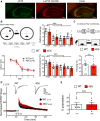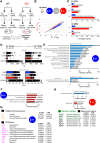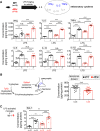Loss of eIF4E Phosphorylation Engenders Depression-like Behaviors via Selective mRNA Translation
- PMID: 29367404
- PMCID: PMC5824745
- DOI: 10.1523/JNEUROSCI.2673-17.2018
Loss of eIF4E Phosphorylation Engenders Depression-like Behaviors via Selective mRNA Translation
Abstract
The MAPK/ERK (mitogen-activated protein kinases/extracellular signal-regulated kinase) pathway is a cardinal regulator of synaptic plasticity, learning, and memory in the hippocampus. One of major endpoints of this signaling cascade is the 5' mRNA cap binding protein eIF4E (eukaryotic Initiation Factor 4E), which is phosphorylated on Ser 209 by MNK (MAPK-interacting protein kinases) and controls mRNA translation. The precise role of phospho-eIF4E in the brain is yet to be determined. Herein, we demonstrate that ablation of eIF4E phosphorylation in male mice (4Eki mice) does not impair long-term spatial or contextual fear memory, or the late phase of LTP. Using unbiased translational profiling in mouse brain, we show that phospho-eIF4E differentially regulates the translation of a subset of mRNAs linked to inflammation, the extracellular matrix, pituitary hormones, and the serotonin pathway. Consequently, 4Eki male mice display exaggerated inflammatory responses and reduced levels of serotonin, concomitant with depression and anxiety-like behaviors. Remarkably, eIF4E phosphorylation is required for the chronic antidepressant action of the selective serotonin reuptake inhibitor fluoxetine. Finally, we propose a novel phospho-eIF4E-dependent translational control mechanism in the brain, via the GAIT complex (gamma IFN activated inhibitor of translation). In summary, our work proposes a novel translational control mechanism involved in the regulation of inflammation and depression, which could be exploited to design novel therapeutics.SIGNIFICANCE STATEMENT We demonstrate that downstream of the MAPK (mitogen-activated protein kinase) pathway, eukaryotic Initiation Factor 4E (eIF4E) Ser209 phosphorylation is not required for classical forms of hippocampal LTP and memory. We reveal a novel role for eIF4E phosphorylation in inflammatory responses and depression-like behaviors. eIF4E phosphorylation is required for the chronic action of antidepressants, such as fluoxetine in mice. These phenotypes are accompanied by selective translation of extracellular matrix, pituitary hormones, and serotonin pathway genes, in eIF4E phospho-mutant mice. We also describe a previously unidentified translational control mechanism in the brain, whereby eIF4E phosphorylation is required for inhibiting the translation of gamma IFN activated inhibitor of translation element-containing mRNAs. These findings can be used to design novel therapeutics for depression.
Keywords: depression; eIF4E; inflammation; phospho-eIF4E; translation.
Copyright © 2018 Amorim et al.
Figures







Similar articles
-
Translational control of depression-like behavior via phosphorylation of eukaryotic translation initiation factor 4E.Nat Commun. 2018 Jun 25;9(1):2459. doi: 10.1038/s41467-018-04883-5. Nat Commun. 2018. PMID: 29941989 Free PMC article.
-
The MNK-eIF4E Signaling Axis Contributes to Injury-Induced Nociceptive Plasticity and the Development of Chronic Pain.J Neurosci. 2017 Aug 2;37(31):7481-7499. doi: 10.1523/JNEUROSCI.0220-17.2017. Epub 2017 Jul 3. J Neurosci. 2017. PMID: 28674170 Free PMC article.
-
Novel translational control in Arc-dependent long term potentiation consolidation in vivo.J Biol Chem. 2009 Nov 13;284(46):31498-511. doi: 10.1074/jbc.M109.056077. Epub 2009 Sep 15. J Biol Chem. 2009. PMID: 19755425 Free PMC article.
-
Does phosphorylation of the cap-binding protein eIF4E play a role in translation initiation?Eur J Biochem. 2002 Nov;269(22):5350-9. doi: 10.1046/j.1432-1033.2002.03291.x. Eur J Biochem. 2002. PMID: 12423333 Free PMC article. Review.
-
Tuning Specific Translation in Cancer Metastasis and Synaptic Memory: Control at the MNK-eIF4E Axis.Trends Biochem Sci. 2016 Oct;41(10):847-858. doi: 10.1016/j.tibs.2016.07.008. Epub 2016 Aug 12. Trends Biochem Sci. 2016. PMID: 27527252 Review.
Cited by
-
Novel Insights into Changes in Gene Expression within the Hypothalamus in Two Asthma Mouse Models: A Transcriptomic Lung-Brain Axis Study.Int J Mol Sci. 2024 Jul 5;25(13):7391. doi: 10.3390/ijms25137391. Int J Mol Sci. 2024. PMID: 39000495 Free PMC article.
-
Raptor-Mediated Proteasomal Degradation of Deamidated 4E-BP2 Regulates Postnatal Neuronal Translation and NF-κB Activity.Cell Rep. 2019 Dec 10;29(11):3620-3635.e7. doi: 10.1016/j.celrep.2019.11.023. Cell Rep. 2019. PMID: 31825840 Free PMC article.
-
Adult neuroplasticity: A new “cure” for major depression?J Psychiatry Neurosci. 2019 Mar 1;44(3):147-150. doi: 10.1503/jpn.190072. J Psychiatry Neurosci. 2019. PMID: 31038297 Free PMC article. No abstract available.
-
Persistent changes in the dorsal root ganglion nociceptor translatome governs hyperalgesic priming in mice: roles of GPR88 and Meteorin.Pain. 2025 Jun 1;166(6):1395-1405. doi: 10.1097/j.pain.0000000000003523. Epub 2025 Jan 28. Pain. 2025. PMID: 39878635
-
Mnk1/2 kinases regulate memory and autism-related behaviours via Syngap1.Brain. 2023 May 2;146(5):2175-2190. doi: 10.1093/brain/awac398. Brain. 2023. PMID: 36315645 Free PMC article.
References
-
- Bob P, Fedor-Freybergh PG, Susta M, Pavlat J, Jasova D, Zima T, Benakova H, Miklosko J, Hynek K, Raboch J (2007) Depression, prolactin and dissociated mind. Neuroendocrinol Lett 28:639–642. - PubMed
Publication types
MeSH terms
Substances
Grants and funding
LinkOut - more resources
Full Text Sources
Other Literature Sources
Medical
Molecular Biology Databases
Miscellaneous
